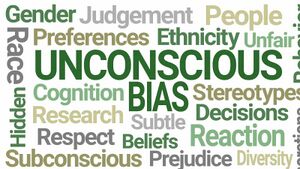Implicit Bias in Healthcare
Original Editor - Tarina van der Stockt
Top Contributors - Tarina van der Stockt, Jess Bell, Ewa Jaraczewska and Stacy Schiurring
Introduction[edit | edit source]
Cities and towns are generally becoming more diverse, but the demographic characteristics of healthcare workers may not always reflect the populations they are treating.[1] Health inequalities are perpetuated when patients from underrepresented groups experience the effect of biases from healthcare workers based on cultural stereotypes.[1] Underrepresented groups can include racial or ethnic populations or minority groups, such as people from the LGBTQIA+ community or persons with disabilities.[1]
To deliver impartial healthcare, we need to be wary of any negative evaluation towards people from a specific group or someone with particular characteristics.[2] Implicit biases are those attitudes and beliefs we harbour about specific people or groups of people at an unconscious level.[3] Even though these biases are unconscious and we might not be aware of them, they still influence our judgements, behaviours and decisions.[4]
Thus, implicit bias refers to a potential disconnection between what someone explicitly believes and wants to do and the unseen influence of negative implicit associations on what they think and how they behave.[2] It also relates to stereotyping, as implicit bias is one of the reasons people attribute particular characteristics and qualities to all individuals belonging to a specific group.[5]
“Implicit biases involve associations outside conscious awareness that lead to a negative evaluation of a person based on irrelevant characteristics such as race or gender.”[2]
Everyone Has Implicit Biases[edit | edit source]
Everyone has implicit biases. This is because our brains have a natural tendency to sift, sort and categorise information, and this can lead to implicit biases.[5]
The following tendencies make us susceptible to implicit bias:[5][6]
- Our brains tend to find patterns and associations in the world.
- Our brains are inundated with information and try to simplify the world by taking mental shortcuts to make it easier to sort through the data.
- Experiences (these do not have to be direct experiences) influence our implicit biases.
We can pick up biases from the people who trained us or be biased towards our own race.[7]
Implicit Bias in Healthcare[edit | edit source]
There is well-established research on the role of implicit bias in health care in social psychology and health care processes.[8]
Most studies on this subject are conducted on doctors and nurses.[9] Almost all the studies in one systematic review[2] showed implicit biases among physicians and nurses. The following characteristics were listed as triggers for implicit bias: "race/ethnicity, gender, socio-economic status, age, mental illness, weight, having AIDS, brain injured patients perceived to have contributed to their injury, intravenous drug users, disability, and social circumstances".[2]
Physiotherapists work in various settings, including hospitals, outpatient clinics and patient homes and come across people from different backgrounds and abilities. Physiotherapists have a higher frequency of patient visits than other healthcare practitioners and, therefore, a trusting patient relationship is crucial. Successful patient outcomes are also linked to the patient’s adherence to the care plan.[9] A physiotherapist's implicit bias can negatively affect patient care.[9]
In a study of 59 physiotherapy participants, the authors found that the sample of orthopaedic and paediatric physiotherapists showed similar rates of implicit bias on race and disability compared to the general public and other healthcare providers.[9]
A study of 6113 occupational therapy and physical therapy assistants looked at implicit bias for people with disabilities. The authors found that the test group had a strong implicit bias. This bias could influence these therapists' interactions with people with disabilities. The authors also concluded that these biases might be reproduced in clinical education, practice and policy.[10]
Clinicians need to be aware that the greater their patient load, overcrowding and cognitive workload, the more implicit bias creeps in.[11]
The Effect of Implicit Bias in Healthcare[edit | edit source]
Implicit bias can negatively influence the following:
- quality and level of care[2]
- assessment - the clinician might not adequately evaluate the patient's needs [12]
- diagnosis[2]
- treatment decisions[2][13]
- treatment[13]
- frequency of eye contact[2]
- interpersonal interaction and connection with the patient[13]
- therapist's interpretation and response to patient feedback[12]
This could result in discrimination and health care disparities as clinicians might give different care to different people. This can also influence patient trust.[11]
Healthcare Discrepancies and Vulnerable Populations[edit | edit source]
A vulnerable individual in health care is typically from a group that is already disadvantaged.[2] Implicit biases by healthcare professionals can mean that people who are already vulnerable are deprived of equitable care.[2] Anyone can be rendered as vulnerable given a specific context, including:[2]
- children
- women
- elderly
- minority ethnic populations
- native populations, first nation people
- immigrants
- individuals who are impoverished
- individuals with low health literacy
- sexual minorities
- people with mental illness
- people who are overweight
- persons with disabilities[2]
Implicit bias is not racism, but it is closely linked and leads to discrimination and different care for different people. Other types of discrimination that can form from implicit biases include sexism, ageism, homophobia, and ableism (discrimination in favour of a non-disabled person).[5]
Testing for Implicit Bias[edit | edit source]
The implicit association test (IAT) was created in 1995 by social psychologists Mahzarin Banaji and Tony Greenwald. The test was published in the scientific literature in 1998.[5] It is the current gold standard to evaluate implicit bias within social constructs. The test is completed on a computer.[9] The computer programme shows the person different images and words and determines how long the person (tester) takes to choose between two images or words.[5] The test consists of different subtests to measure racial attitudes and bias related to weight, gender, disability and other areas.[5]
An example of one of the tests is that the tester will be presented with images of faces of people from different racial backgrounds, together with a negative or positive word. The tester is asked to "click on a positive word when they saw an image of someone from one race and to click on a negative word when they saw someone of another race".[5]
When a person clicks on the negative words listed every time the face of someone from a particular race appears on screen, the researchers suggest that the person holds a negative implicit bias towards the individual of that race.[5] Taking the IAT can help you realise that everyone, including you, has implicit biases. Recognising these biases for what they are increases the likelihood that you won’t let them affect your behaviour in the future.[6]
Here is the link to the test: Implicit Association Test (IAT)
Strategies to Address the Negative Impact of Implicit Bias[edit | edit source]
By being aware of the potential impact of implicit social biases, you can participate in overcoming discrimination, stereotypes and prejudice.[5]
Reducing disparities in access to and delivery of health care services and administration[edit | edit source]
- Medical leaders and policy makers also have implicit biases.[11] Thus, it is important for them to consider and address their biases and how they affect decision-making.
- Administrators can facilitate a work environment that is supportive of reflection on implicit bias and aware of the potential impact it can have on patient care, outcomes and interactions.[9]
- It is important to recognise that the physiotherapy workforce does not always reflect the diversity of their patient population. This is especially true in countries where most physiotherapy and other healthcare services are delivered by white clinicians without disabilities.[9]
- Institutions can play a part by creating an inclusive environment. This can be accomplished by implementing diversity, equity, and inclusion training as making employment and training of people of colour and individuals with disabilities a priority.[9]
- A once-off training as the only intervention will NOT stop implicit bias affecting patient care because after a course, people go back to their work or learning environment, which is filled with structural determinants and patient outcomes that reinforce implicit bias. Training must go hand-in-hand with other systemic interventions in and outside the healthcare system to address bias and discrimination.[11]
Practical strategies for healthcare professionals[edit | edit source]
Understanding implicit bias is critical because positive and negative unconscious beliefs can lead to structural and systemic inequalities. However, because it operates outside our awareness, we first need to become conscious of it, if we want to reduce it.[6]
- Self-reflection[9][12]
- Take time to pause and reflect on potential biases[5]
- Practise mindfulness to become more aware of your thoughts and biases[5]
- Practise cultural humility by committing to be respectfully curious while reflecting on your own implicit biases and honouring the customs, beliefs and values of other people or groups[12]
- Practise empathy by considering the experiences from the point of view of the person or patient who is different from you[12]
- Counter-stereotyping
- Consciously work on changing your stereotypes when you identify them[14]
- Increase the time you spend with people from different backgrounds and cultures[5][6][12]
- You can replace those biases with positive examples of the stereotyped group[5]
- Focus on seeing people as individuals instead of stereotypes[5]
- Increase your exposure to information that defies stereotypes that persist about groups or individuals[6]
- Perspective-taking can help healthcare professionals increase patient satisfaction when the patient and healthcare professional are from different ethnicities.[14] This means the healthcare professional is trying to understand the situation from the patient’s perspective.
- Be aware of/change your verbal/non-verbal messages[13]
- Engage in or provide workplace training on implicit bias[6][12]
- Create or be part of implementing policies and initiatives to promote equity and inclusion in your place of work[12]
Optional Video[edit | edit source]
Resources[edit | edit source]
References[edit | edit source]
- ↑ 1.0 1.1 1.2 Marcelin JR, Siraj DS, Victor R, Kotadia S, Maldonado YA. The impact of unconscious bias in healthcare: how to recognize and mitigate it. The Journal of infectious diseases. 2019 Aug 20;220(Supplement_2):S62-73.
- ↑ 2.00 2.01 2.02 2.03 2.04 2.05 2.06 2.07 2.08 2.09 2.10 2.11 2.12 FitzGerald C, Hurst S. Implicit bias in healthcare professionals: a systematic review. BMC medical ethics. 2017 Dec;18(1):1-8.
- ↑ Bouley TM, Reinking AK. Implicit Bias: An Educator’s Guide to the Language of Microaggressions. Rowman & Littlefield; 2021 Nov 14.
- ↑ Implicit Bias. National Institutes of Health.
- ↑ 5.00 5.01 5.02 5.03 5.04 5.05 5.06 5.07 5.08 5.09 5.10 5.11 5.12 5.13 5.14 Cherry K. How does implicit bias influence behavior. Explanations and Impacts of Unconscious Bias. Updated March 2023. Verywell Mind.
- ↑ 6.0 6.1 6.2 6.3 6.4 6.5 Nikolopoulou, K. What Is Implicit Bias? | Definition & Examples. January 2023. Scribbr.
- ↑ White III AA, Chanoff D. Seeing patients: Unconscious bias in health care. Harvard University Press; 2011 Jan 15.
- ↑ Blair IV, Steiner JF, Havranek EP. Unconscious (implicit) bias and health disparities: where do we go from here?. The Permanente Journal. 2011;15(2):71.
- ↑ 9.0 9.1 9.2 9.3 9.4 9.5 9.6 9.7 9.8 Dunn B, Mcintosh J, Ray L, McCarty D. The Prevalence of Implicit Bias in Practicing Physical Therapists. Carolina Journal of Interdisciplinary Medicine. 2022 Dec 19;2(1).
- ↑ Feldner HA, VanPuymbrouck L, Friedman C. Explicit and implicit disability attitudes of occupational and physical therapy assistants. Disability and Health Journal. 2022 Jan 1;15(1):101217.
- ↑ 11.0 11.1 11.2 11.3 Vela MB, Erondu AI, Smith NA, Peek ME, Woodruff JN, Chin MH. Eliminating explicit and implicit biases in health care: evidence and research needs. Annual review of public health. 2022 Apr 5;43:477-501.
- ↑ 12.0 12.1 12.2 12.3 12.4 12.5 12.6 12.7 Banks TM. Implicit bias in occupational therapy practice. April 2023. OT Practice Magazine. Vol.28, Issue 4, pp. 10-14. American Occupational Therapy Association.
- ↑ 13.0 13.1 13.2 13.3 Setchel J. What is implicit bias & how it manifests in physiotherapy interactions with persons considered overweight or obese. May 2019. World Confederation of Physical Therapy Congress 2019 Geneva.
- ↑ 14.0 14.1 Zestcott CA, Blair IV, Stone J. Examining the presence, consequences, and reduction of implicit bias in health care: a narrative review. Group Processes & Intergroup Relations. 2016 Jul;19(4):528-42.









